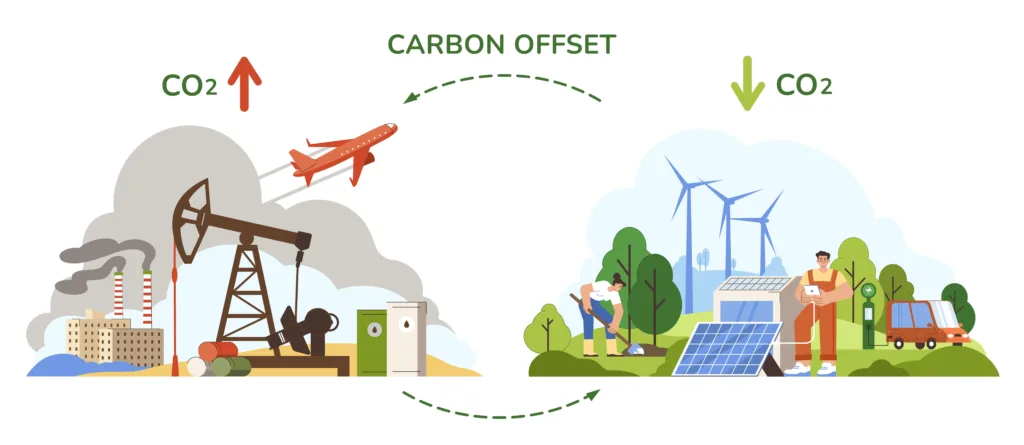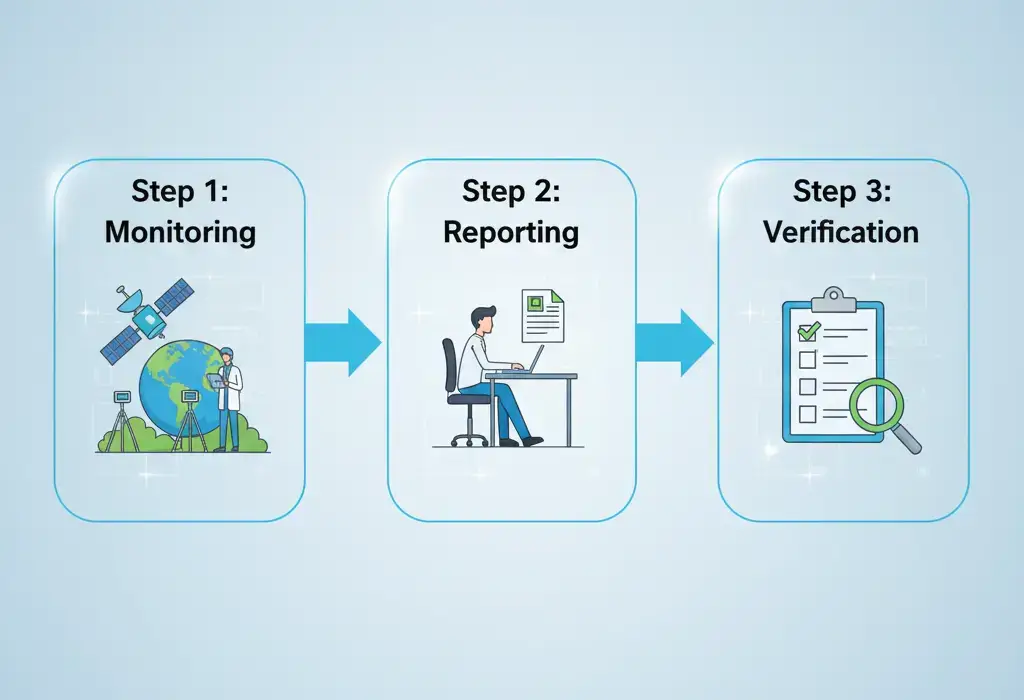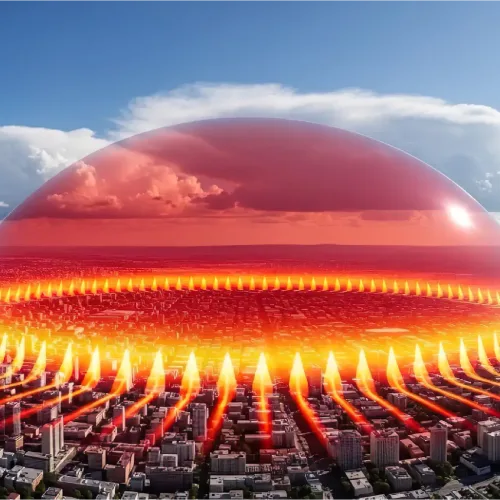Carbon credits often feel complicated and far away concept. You might hear about them in news stories and company reports. But the science of carbon credits is actually a bridge, it connects the climate science of our planet with the world of economics. In this article, the Learning Breeze team will break that bridge down for you. We’ll explain the science of carbon credits in clear words, show you how they are measured, what makes them reliable, and why they matter.
At the heart of it, the idea is simple. One carbon credit proves that one metric tonne of carbon dioxide equivalent has been kept out of the atmosphere or removed from it. This comes straight from the science of carbon credits. We can measure it, and we can verify it. Think of a carbon credit like a “receipt” for cleaning up pollution. It isn’t just a promise, it’s a certified fact backed by real data. By the end of this guide, you’ll see this link clearly.
What Are Carbon Credits?
A carbon credit works like a license. It gives the holder the right to release one tonne of carbon dioxide (CO₂) or the same amount of another greenhouse gas (tCO₂e). Projects that cut down emissions, like building a solar farm or planting a forest, create these credits. Once created, the projects sell the credits. Companies or even countries buy them to balance out the pollution they produce.
The science of carbon credits makes it clear that a credit and an offset are not the same thing. A credit is the actual unit, while an offset is the action of using that unit. When a company buys a carbon credit, it applies it to cancel out its own emissions. In simple words, the company pays someone else to remove or prevent the same amount of greenhouse gases it puts into the air. The credit acts as the tool, and the offset is the way it’s used.
Take this example: imagine a factory releases 100 tonnes of CO₂. To balance this, the factory buys 100 carbon credits. Those credits might come from a tree-planting project that removed the same 100 tonnes of CO₂ from the atmosphere. That’s how carbon trading works, it directly connects polluters with those cleaning up the air.
Carbon Credits vs Carbon Offsets: What’s the Difference?
Let’s clarify the difference between carbon credits and carbon offset.
- Carbon credits are tradable certificates representing emissions reductions or removals
- Carbon offsets occur when you use those credits to neutralize your own emissions
Carbon credits are like renewable energy certificates you can buy and sell. Carbon offsets happen when you actually use those certificates to cancel out your carbon footprint.
The science behind both concepts remains the same – rigorous measurement, monitoring, and verification guarantee that one credit truly equals one tonne of CO₂e impact.
The Science Behind Carbon Credits
To better understand carbon credits, let’s first look at the carbon cycle. Carbon constantly flows across Earth, through the air, land, and oceans. Greenhouse gases like CO₂ trap heat in the atmosphere. Plants, soil, and oceans naturally pull some of this carbon out, acting as carbon sinks. On the other hand, factories and cars release carbon into the air, creating emission sources.

Carbon credits revolve around boosting these sinks or cutting down the sources. Don’t worry, we’ll break it down in a simple way.
How Scientists Measure Reductions
Scientists use clear methods to measure carbon reductions and removals. They don’t guess, it’s all based on data and math. Their goal is to calculate the exact amount of emissions reduced or removed, which forms the foundation of carbon credit measurement.
Take a forest project as an example. Scientists track how trees grow and use that data to figure out how much carbon the forest stores. Trees absorb CO₂ from the air as they grow, and about half of a tree’s dry weight is carbon. By measuring a tree’s size and weight, scientists can estimate how much carbon it holds.
Let’s break it down with numbers. Imagine planting 100 pine trees. On average, one pine tree stores about 48 pounds of carbon each year.
1. Step 1 – Total carbon stored:
100 trees × 48 pounds each = 4,800 pounds of carbon.
2. Step 2 – Convert carbon to CO₂:
Carbon is lighter than oxygen. One carbon atom has a mass of about 12 units, while two oxygen atoms together weigh about 32 units. A CO₂ molecule weighs about 44 units in total. That means carbon makes up 12/44 of the CO₂ molecule’s weight.
So, 4,800 pounds × (44 ÷ 12) ≈ 17,600 pounds of CO₂.
3. Step 3 – Convert to metric tonnes:
1 metric tonne equals about 2,205 pounds.
17,600 ÷ 2,205 ≈ 8 tonnes of CO₂.
This means the project earns roughly 8 carbon credits per year. That’s a simple example of how carbon credit calculations work.
Other projects follow different methods. For soil carbon projects, scientists collect soil samples and track changes in carbon levels over time. In renewable energy projects like wind farms, they measure electricity generation and calculate how much CO₂ emissions they avoided by not relying on fossil fuels. Each method gives a scientific way to measure carbon savings, which is at the heart of carbon offsets.
MRV: Monitoring, Reporting, Verification
Trust is the heart of a carbon credit. We build this trust through MRV — Monitoring, Reporting, and Verification. This process works like a scientific audit, showing that every emission cut or removal is real and lasting.
The MRV Process in Plain Words
Monitoring:
The project keeps collecting data over time — like tree measurements, soil samples, or electricity output. Researchers gather this information for long periods using on-site tools or remote sensing methods.
Reporting:
The project owner gathers all the data and prepares a detailed report. This report explains how many tonnes of CO₂e were reduced, following a strict rulebook every step of the way.
Verification:
An independent third-party auditor reviews the report. These outside experts examine the data, methods, and the project itself. They make sure everything is correct and then confirm the number of credits.
Visuals play a big role here. Imagine a diagram that shows the MRV process step by step. It begins with a project, moves into data collection, flows into report writing, and ends with an independent auditor adding the final checkmark. The process may feel complex, but it’s what makes the credit reliable and trusted.

The Problem with Precision
Science never gives results that are 100% exact, there’s always some level of uncertainty. For example, a satellite may not capture a perfect reading, or a soil sample may fail to represent the entire area. To make this clear, scientists add error bars, which show the possible range of outcomes. A strong carbon credit standard keeps this uncertainty as low as possible, which makes the credit more valuable.
If you’d like to dive deeper into the exact methods and calculations, The Carbon Footprint Handbook is a great resource to explore.
Key Challenges and Issues in Carbon Credits and Carbon Markets
Even with strong science, carbon credits face challenges. These issues must be handled to ensure credits are effective.
1. Additionality
This rule is at the heart of carbon credits: a project counts only if it is additional. In simple terms, the emissions cuts must happen because of the carbon credit market. If they had happened anyway, the project doesn’t qualify.
For example, if a power company switches to solar just because it’s now cheaper, that shift isn’t additional. Giving a credit here adds no real benefit, since no new emissions are reduced.
To be valid, a project must show that carbon credits made the project possible.
For Example: A company builds a wind farm because it can sell both electricity and carbon credits. Without the credit sales, the wind farm would never have been built. That makes the project additional.
2. Permanence
This means emission cuts must last forever. Every project has to keep CO₂ out of the air. Take a forest project as an example—it always carries risks. Fires, diseases, or land-use changes can wipe out the stored carbon and send it back into the atmosphere. That’s why projects need strong backup plans. They also need to watch and monitor the site for years to make sure the carbon stays locked away.
3. Leakage
Sometimes a project helps in one place but creates a problem in another. Imagine a project that saves a forest from logging. That sounds great. But if the logging company simply moves to a different forest and cuts trees there, the benefit disappears. This situation is called leakage. Even though the project protected one forest, the overall emissions stay the same. That’s why project developers must show that their work doesn’t just push the problem somewhere else.
For Example: A carbon project prevents deforestation in one forest. The loggers then shift to a nearby forest and continue cutting trees. The carbon released from this new deforestation is considered “leaked” from the project.
4. Double-Counting
This problem is actually pretty simple. One emission’s reduction can only count once. No two parties can sell it or claim it at the same time. To keep things fair, a public registry tracks every carbon credit. The registry records each credit, and once someone uses it, that credit is retired. This way, no company can double-claim the same reduction.
For Example: Imagine a project removes 100 tonnes of CO₂. It sells 100 credits to Company A. Once that happens, Company B can’t turn around and say it also offset its emissions with the same 100 tonnes.
Carbon Removal vs Avoidance
There are two main types of carbon credit projects, and each plays a different role in fighting climate change.
Carbon avoidance projects stop new emissions before they enter the atmosphere. They prevent pollution at the source. For example, a solar farm replaces a coal power plant, or a landfill traps methane gas instead of letting it escape. These projects matter because they block the problem before it begins.
Carbon removal projects take carbon that’s already in the air and pull it back out. Think of them as a clean-up crew. Reforestation works by absorbing CO₂ as trees grow, while new technologies like direct air capture or carbon capture use machines to filter CO₂ straight from the atmosphere.
For a simple visual, imagine a timeline. With carbon avoidance, the line stays low because emissions never rise. With carbon removal, the line drops as the total amount of carbon in the air decreases. Both approaches are powerful—and we need both to tackle climate change effectively.
The Market Side
Carbon credits work on a clear science. Markets serve as the places where these credits get bought and sold. There are two main kinds of carbon markets.
Compliance markets run under government rules. These markets exist to help countries meet climate goals. For example, the European Union’s Emissions Trading System (EU ETS) puts a cap on emissions from big polluters. Companies must either reduce their emissions or buy credits from others to stay within the limit.
Voluntary markets give companies and individuals the choice to act. Many businesses use these markets to support their net-zero pledges. A company that promises to be carbon neutral buys credits to balance out its emissions. This market grows because customers push for climate action and companies want to show leadership.

The cost of a carbon credit can change a lot. Credits from new, advanced carbon removal projects often cost more. Credits from older renewable energy projects usually come cheaper. Price depends on the project type, location, and certification. New reforms, like the ICVCM approval process, aim to add more trust and value to these markets.
Case Studies
A Nature-Based Project: Mangrove Restoration
Mangroves grow along coastlines, and they store huge amounts of carbon in their roots and the soil beneath them. In Southeast Asia, one project restored mangrove forests by planting new trees and protecting the ones already standing. Scientists tracked the progress using satellite images and field surveys. They measured both tree growth and the carbon stored. The results were striking: just one hectare of restored mangroves can hold up to 1,000 tonnes of carbon. The project’s carbon credits came out top quality, proving one thing—nature-based solutions are a powerful way to remove carbon from the atmosphere.
A Tech-Based Project: Direct Air Capture
Direct air capture (DAC) is an emerging technology that works like a giant air filter. Large fans pull air into a machine, where special chemicals grab the CO₂. The captured CO₂ is then pushed deep underground for storage. This process removes carbon directly from the atmosphere. Companies like Carbon Engineering in Canada are leading the way in this field. Running these projects costs a lot, which makes their credits very expensive. The science behind them is solid, but the projects remain small in scale. The key takeaway? DAC has the potential to change the game, but it needs more funding and growth before it can compete with cheaper, nature-based solutions.
The Future of Carbon Credits
The future of carbon credits looks more transparent and science-driven. New technologies will lead the way. Artificial intelligence will quickly analyze satellite data, making MRV faster and more reliable. Blockchain will record every credit in a public and unchangeable system, stopping any chance of double-counting. As integrity and openness grow, carbon credit projects will become stronger and more trustworthy.
Carbon credits will play an important role in global climate goals. They act as a bridge between science and markets, helping us move toward a low-carbon future. While they can’t solve the climate crisis on their own, they can speed up progress. By supporting projects that would not exist otherwise, carbon credits make it possible to clean our atmosphere and create real impact.
Conclusion
Carbon credits aren’t a quick fix—they’re a tool. This tool relies on solid science. It works by measuring and verifying how much emissions are reduced or removed. We explored the science behind carbon credits and the challenges they face, from additionality to permanence.
We also saw how science and technology shape real projects, whether in nature-based solutions or the emerging field of direct air capture. In every case, science drives the process.
The world of carbon markets and climate solutions can feel complex, but when you understand the basic science, it all starts to make sense. You realize how a single credit can truly make a difference. The science is clear, and so is our mission.
This guide is here to help you think more critically and confidently about climate solutions.
Frequently Asked Questions About Carbon Credits
A carbon credit is a certificate proving that one metric tonne of carbon dioxide (CO₂) or its equivalent has been removed from or prevented from entering the atmosphere. It acts like a receipt for real climate action.
They put a price on pollution. Companies or individuals can buy credits from projects that reduce emissions, like forests or renewable energy. This balances out their own emissions while funding climate-friendly solutions.
Yes, when they follow strict MRV standards — Monitoring, Reporting, and Verification. Independent auditors check the data to ensure the reductions are real, measurable, and permanent.
Both companies and countries buy carbon credits. Businesses use them to meet net-zero pledges, while governments use them in compliance markets to stay within emission limits.
Recommended Resources for Curious Minds
- Dirt to Soil: One Family’s Journey into Regenerative Agriculture by Gabe Brown
- Drawdown: The Most Comprehensive Plan Ever Proposed to Reverse Global Warming by Paul Hawken
- Digital Carbon Scale for Laboratory Use
- The Carbon Crunch by Dieter Helm




